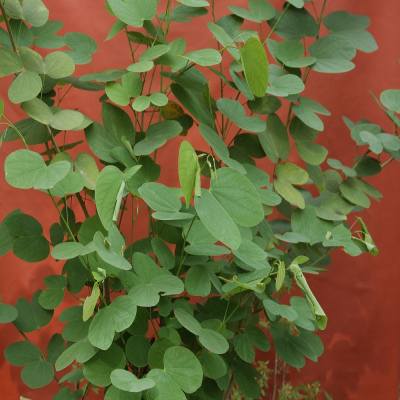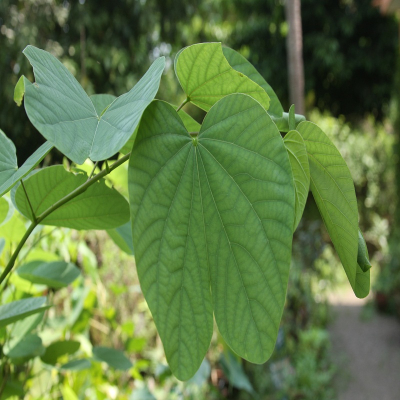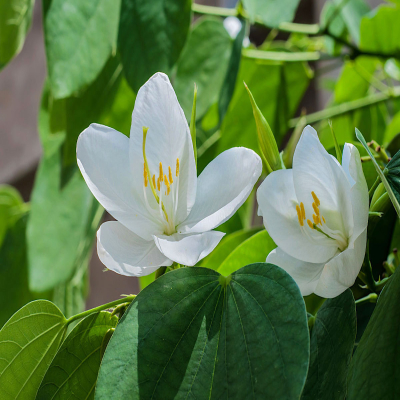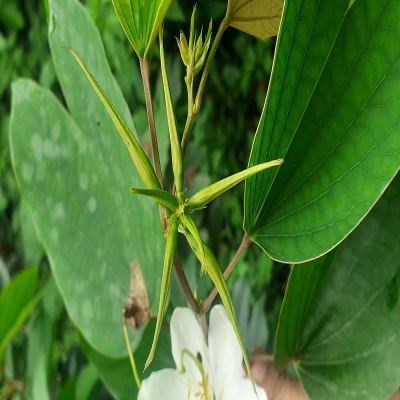Bauhinia acuminata L.
Family : Fabaceae
Parts Used : Leaf , Bark
Vernacular Names :-
| English | : | Bauhinia |
| Malayalam | : | Vella mandaram, Malayathi |
| Hindi | : | Ashta, Asoda, Guriaa, Marvil |
| Sanskrit | : | nupushpaka, Kushali, Vanaraja, Yugmapatra, Svetakanchan |
| Bengali | : | Banraj |
| Gujarathi | : | Apta. |
| Kannada | : | Vana santig |
| Tamil | : | Arai, Arikka, Sallagi, Aram, Mandhari arikka |
| Telungu | : | Pachare, Adibiyavise, Manjiyare |
Distribution and habitat: Through out India.
Botany: A small crooked tree with dark scabrous bark. Branches numerous and drooping.
- Leaf: Broader than length, 2.0-5.0 X 2.5-6.3 cm, green and glabrous above, white and more or less tomentose beneath, leaves usually cordate. Petioles 6-16 cm long, pubescent.
- Flowers: Terminal or leaf opposed racemes; buds pointed and pedicels 3-4.5 mm long. Calyx pubescent, tube very short; limb 6-8 mm long. Petals oblanceolate, acute, 10-11.5 mm long, white or pale yellow. Stamens 10, all fertile; filaments densely hairy at the base. Ovary pubescent; stigma sessile.
- Fruit: Pods stalked 15-25 by 1.32- 2.2 cm, glabrous and turgid; stalk 2-2.5 cm long.
- Seeds: 12-20, oblong, compressed, 6-10 by 4.5-6 mm, black.
Chemical constituents:
- Flowers contain flavanoids-kaempferol-3-galactoside and kaempferol-3-rhamnoglucoside.
- Stem bark yields hentriacontane, octacosanol and stigmasterol.
- Stem yields b-sitisterol, lupeol and a flavanone glycoside-5, 7-dimethoxy flavanone 4-O-a-L- rhamnopyranoside-b-D-glucopyranoside.
Uses:
- Used against tumor. Leaves used against headache, malarious fevers
- Seeds possess human blood agglutinating activity.
- Stem bark is hypothermic, Neuro tonic and depressant.
- Bud, flower, leaf and stem bark are antibacterial.
- Stem possesses juvenoid activity. Bark is alterative, tonic, antileprotic and antirheumatic.
- Bud is antidysenteric.
- Root is carminative and antidote for snakebite.
- Bark, flower and root promote suppuration.
- Bark and bud are astringent and vermifuge
Agro technology
Propagation: By seed. Seeds are formed in February-March. Seeds collected from the dried pods are soaked in water for 12 hours before sowing in seedbeds. At four-leaved stage, they are to be transferred to polybags. Two-month-old seedlings from polybags are used for field planting at a distance of 6-7.5 m.
Harvesting: The plant flowers on the third year. At the end of tenth year the tree can be cut and wood used for medicinal purposes.





